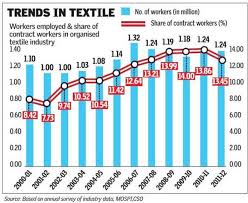
India Ratings and Research (Ind-Ra) expects input costs for textile players to remain high amid high cotton and crude oil prices. While demand recovery is likely to benefit cotton players to maintain their profitability, earnings for the synthetics segment may come under pressure owing to the prevailing overcapacity domestically.
Supply Moderation to Support Cotton Prices: Ind-Ra expects cotton prices to stay firm during FY19, on the back of a tight demand-supply scenario due to impending supply moderations globally amid a healthy demand.
Lower-than-expected fibre production in the current season (2017-2018; October-September) owing to crop infestation and likely acreage drop in India in the coming season (2018-2019) as well as adverse weather conditions in other key cotton growing nations could pose supply constraints. On the other hand, India's domestic demand, which had plateaued for the past two seasons, is poised to grow during 2017-2018. Exports from India are likely to rise as well on account of several reasons including the spurt in demand from China, Indian cotton trading at a discount to the global prices as well as a depreciating rupee.
India's Stock-to-use Ratio to Fall Further: The stable supply and rise in global demand will lower carry-over stock for the coming season and reduce the stock-to-use ratio. The Cotton Association of India has estimated the closing stock for 2017-2018 to shrink to 1.6 million bales (2016-2017: 3.0 million bales, 2015-2016: 4.50 million bales) and the stock to use ratio to 5% (10%, 15%).
Cotton Textile Margins to Re
emain Stable: Despite the firm cotton prices, Ind-Ra expects margins across the cotton value chain to remain more or less stable; primarily because a sustained demand from the end-user segments will allow manufacturers to pass on the price rise. Cotton yarn prices even displayed an uptick in April-May 2018.
Synthetics Margins Under Pressure: India's synthetic textile players could witness a material margin contraction during FY19, due to their inability to pass on the price rise of crude oil-based raw materials, owing to the prevailing overcapacity domestically. Within the synthetic segment, exporters and integrated players will be better placed to absorb a higher input cost, while standalone spinning units may be the most impacted.
Credit Profiles to Moderate for Man-Made Textiles: Within Ind-Ra's rating universe, the credit profiles of synthetic textile players (particularly non-integrated yarn manufacturers) are likely to moderate on account of lower profit margins and higher working capital requirements.
While cotton textile players will continue to witness a high input cost, a robust demand may allow them to pass on the same to their customers, thereby protecting their margins. Nonetheless, demand from the end-user segments remains a key monitorable for the margin to sustain
0 thoughts on “Ind Ra Input Prices to Remain High for Textile Sector”